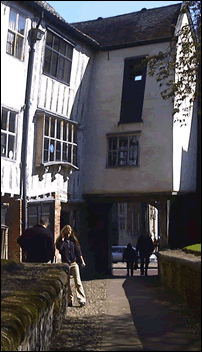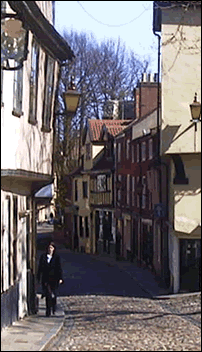You are here: Home > Old Norwich > Streets
Old Norwich - Streets

Norwich has long been renowned for its many churches and beautiful houses and gardens, but its ancient streets, still retaining much of their early character, are equally notable. Princes Street is one such 'piece of picturesque Norwich', and it has been beautifully restored. Among its buildings are many from the sixteenth and seventeenth centuries, blended with modern offices and homes.
Leading off Princes Street is the winding and cobbled Elm Hill, probably the best-loved street in the city. A century ago it was derelict, but the street was taken over by the Corporation after the First World War. They proposed to develop Elm Hill, but were fortunately persuaded to restore it instead, with superb results, and today the street has become a centre of the antique trade and one of the main attractions of Norwich.
At the corner stands the Briton's Arms, once an inn but now a charming coffee-house, which has half-timbered walls, a thatched roof and a three-storied gable end. Outside the Briton's Arms grew the original Elm tree from which the street took its name. A little further down can be seen the entrance to the ancient monastery of Father Ignatius, while at the lower end stands the church of at Simon and St Jude, now used as the Scout and Guide Store.

Turning right at this church, we come to Tombland, the original market place in Norwich, and Tombland Alley.
Many other streets repay exploration, especially those in the Colegate area, with their mixture of medieval churches and houses, early nonconformist chapels, seventeenth-, eighteenth- and nineteenth-century buildings and pleasant modern housing. King Street, one of the city's most ancient streets, has medieval and seventeenth-century houses, particularly Dragon Hall and the Music House (now part of Wensum Lodge, an adult education centre).
Thomas Ivory built the Assembly House, a fashionable meeting place, in 1754 on the site of a medieval college of priests. Restored in 1950, it functioned as an arts and social centre, but suffered a serious fire in 1995. It was reopened in 1997, having been fully renovated - next door is the Theatre Royal.
Another of the city's theatres is the well known Maddermarket, founded by Nugent Monck and the Norwich Players in 1921. This enthusiastic group of amateurs converted the old building into an Elizabethan style theatre. The first building used by the Norwich Players was the Music House (now part of Wensum Lodge) in King Street. This was also home to Norwich International Club between the early 1950s and mid 1970s. Originally built in the 1170s by a wealthy Jew, it is the oldest house in Norwich. The vaulted cellars still survive.
St Andrew's Hall, which was the nave of a Dominican friary church before the Reformation, has been used for a wide variety of civic and public functions since the sixteenth century. Blackfriars Hall, once the chancel of the church, continued in use for religious services (for a while it was the Dutch church), then it too became a public hall.
